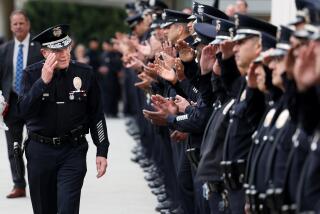The New Agents of Peace on the Streets
- Share via
Gang-related violence and homicides are up in the city after years of falling rates. Government, business and religious leaders, community activists, law enforcement and social agencies are scrambling to propose plans to curtail the violence. Yet, most of these well-meaning attempts will fail.
For one thing, the responses reek of old strategies that can be lumped under the catchall heading of “anti-gang.” One newly formed coalition of activists, for example, called for more funding for anti-gang programs. But what’s needed is not more “anti” policies. Instead, pro-youth, pro-community, pro-family, pro-compassion and pro-the-long-haul policies are needed.
This is why the anti-gang units of the Los Angeles Police Department had to be dismantled. CRASH essentially created a larger, better-armed gang to deal with gangs. As we’ve seen with Rampart, this only invited abuse and criminal activities. The innocent got pulled in with the guilty. People were framed. Others were killed or maimed.
This also undermined what little confidence people had in law enforcement. I don’t buy the argument that the demise of the anti-gang units has emboldened gang members to become more visible. But even if this were true, returning to CRASH or a similar tactic shouldn’t be on anyone’s agenda.
It’s time to imagine a new peace process.
This means reaching out to the very people who are supposedly behind the violence. Yes, to the gangs and the youth most affected by them. This has to include street leaders, many of whom wield more palabra or juice than any police officer, school official or outside youth organizer will ever have.
There is a new generation of gang leaders establishing themselves in the streets. They shouldn’t be dismissed or demonized out of hand. However, these youth are not going to respond to half-hearted peace efforts, empty promises or even threats. There will have to be consistent, continuing and painstaking street work to determine who and what is behind the upsurge in violence.
It’s time to bring the up-and-coming leaders to the table and to set up the proper mentoring and teaching so these leaders can become competent agents of peace instead of war. Most officials and agencies have been afraid to try this approach. But it’s the one that in the past resulted in a measure of peace. It wasn’t that long ago that war zones in South-Central, the northeast San Fernando Valley and East L.A. saw violence fall after leading gang members were involved in the peacemaking.
This is not to downplay the pressing need for a long-range comprehensive response that includes decent, well-paying jobs, life and skills training, greater education opportunities and drug and psychological treatment.
But there must also be “fire brigades” to manage hot spots of gang violence. These brigades should include the players who have already forged peace in communities through street ministries, gang intervention projects and truce efforts. Among these groups are N.O.G.U.N.S., Unity One, Barrios Unidos, Communities in Schools, the Assn. of Community-Based Gang Intervention Workers, Amer-I-Can, the Urban Peace Network and Homies Unidos, the Pico-Union group hard hit by Rampart officers.
These are the peacemakers, some of whom are former gang members who still have an ear to the ground. They daily struggle with the most-troubled youth, defusing violent confrontations; they take them to sports events, cultural outings or the woods; they link them to work or alternative schools; they involve youth in programs that give back to community through active service.
One of these peacemakers is Frank Chavez, a former drug user and gang member who now holds a masters degree. Despite severe health problems, he helps bring indigenous spirituality to East L.A. gang youth. Others include William “Blinky” Rodriguez of the San Fernando Valley and Henry Toscano of East L.A., who have taken their ministries for Christ among the people nobody else will work with.
There are many others, like Alex Sanchez, the former gang member and Homies Unidos activist now threatened with deportation after his arrest by Rampart officers, allegedly in violation of LAPD policy. It’s people like them who have saved countless lives, yet most don’t get recognized or paid commensurate with their skills.
These peace workers continue to work despite having attended too many funerals, seeing too many of their charges sent to prison for extraordinary amounts of time and having been shortchanged by government and business representatives time and time again. Some peacemakers have put in five, 10 and even 30 years of work. Some have lost their own children to violence or prison. They’ve been at the press conferences and sat in countless meetings with bureaucrats. They’ve faced character assassinations. Yet, regardless of setbacks, they’re still putting their lives on the line without fanfare or meaningful support.
It’s clear we can’t go back to the fragmentation and repressive police tactics that have characterized anti-crime efforts. Peace is a process. It’s a plan. It is a way of life.
It’s time for politicians, businesses, schools, churches and law enforcement to align with what these street workers and peacemakers have been doing to make peace in the community a reality. *
More to Read
Sign up for Essential California
The most important California stories and recommendations in your inbox every morning.
You may occasionally receive promotional content from the Los Angeles Times.













